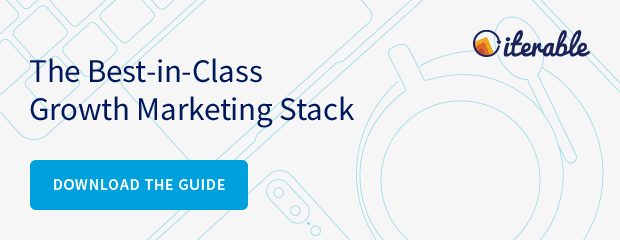For years, businesses have relied on the all-in-one suite as the go-to solution for a consolidated technology ecosystem. The prevailing thought being, “If my data is feeding into one system, then I’ll be able to find insights more easily.”
Over time, however, functional gaps in these suites have grown, prompting companies to look for more specialized solutions to solve the more complex issues that suites couldn’t address.
Insert the growth marketing stack—one that employs integrations to foster communication between systems for greater insights and more effective data management.
For today’s marketers, there are numerous options to fill out this modern stack. This may seem daunting, but in reality, it means you have the opportunity to thoroughly evaluate which solutions fit your business needs and can create the ideal stack for them.
We touched on starting this process in our recent post outlining a guide for building a best-in-class stack. It’s less about what’s available in the market and more about what your organization needs for success.
Is your team lacking acquisition analytics? Then you can start building your stack based on the lead capture platform of your choosing. The key to an ideal growth marketing stack is filling priority gaps for your organization while fostering a system that enables detailed insights.
While great in theory, it helps to have an example to achieve a better sense of how to build an ideal growth marketing stack. So, we’re delighted to bring you Shift’s story from Segment’s recent Stacked Seattle event, showcasing how Shift identified their priorities and goals and made their selections to fill out their stack.
The Shift Story
Unless you’re a celebrity with an airport hangar full of luxury vehicles, buying and selling a car doesn’t happen too often.
This means Shift, your one-stop shop to browse, buy, and sell cars, operates in longer lifecycles with low purchase frequency. For most, this is a big life event—either buying or selling a car—so it can take some time, with varying levels of engagement and interest.
For a company like Shift, it’s crucial to maintain engagement—and re-engagement—with customers or potential buyers. The company wants to maintain a relationship that continues for months, even years, down the road to establish themselves as a customer’s go-to source for auto-related information.
As Shift’s team worked towards building individual relationships with customers—largely through email—they noticed gaps in their stack’s capabilities. Data-based insights were falling through the cracks.
To remedy the situation and make the most of their data, Shift turned to a new, ideal stack for their business that features Iterable and Segment.
But like any successful stack-building story, Shift started by identifying their priorities and challenges.
Addressing Goals for the New Stack
First and foremost, Shift’s systems were not automated. From their ESP to their data management processes, the need for manual input reached an untenable scale.
As a result, the Marketing team frequently pulled engineering resources to create workarounds for better data ingestion to feed their email campaigns.
However, even this process became difficult as the stack architecture siloed data in disparate systems. Since Shift’s sales process could occur either online or offline, data flowed inward from a variety of sources and into numerous solutions in their stack.
But, this data would rarely be used outside the initial platform that collected it. Communication between systems was either minimal or nonexistent.
Siloed data meant the Shift team had an incomplete view of the customer journey. There was little insight into what communications customers received, what triggered these communications, and how—or if—the customer responded.
In essence, the team found itself incapable of using its data to its fullest extent.
When creating and sending emails, the use of different systems made it more difficult to maintain consistency in branding. The various responsibilities in building an email were spread across the organization and resulted in stylistic inconsistencies.
Due to system limitations and differing feature capabilities, templates often looked as if they were sent by three different companies rather than just the one.
And with these different systems, processes for sending email campaigns out required input from multiple teams. This manual process resulted in numerous errors.
As it stood, Shift was left with a loose collection of building blocks acting individually rather than a cohesive stack working together for the betterment of the company.
Shift’s Ideal Growth Marketing Stack
The first step in any stack overhaul is identifying the business needs and goals, of which Shift’s was to move from personalization to individualization.
Shift needed a stack that checked all of their boxes and did so simply. The resulting stack placed the power of Iterable and Segment at the center.
The biggest benefit from their new stack architecture? Data available to all systems.
Data is the foundation of any great marketing campaign. If you have an incomplete view, opportunities and insights are falling by the wayside.
By using Periscope to store data and Segment to route it to Iterable for their cross-channel campaigns, Shift saw three immediate advantages to their enhanced growth marketing stack.
1. Data Feed Recommendations
Previously, if a customer had viewed a car that had just been sold, the system would inform the user of the sale and that was that. Now, with real-time updates from data feeds, Shift can provide recommendations for similar cars, keeping the user engaged rather than sending them away empty-handed.
2. Template Flexibility
In Shift’s prior systems, template creation was siloed and rigid. Certain segments of the email, such as the footer, had to either remain static or be manually updated. This led to considerable confusion as their footer contained the headquarters’ address, not a nearby location to purchase a car.
With Iterable’s snippets and metadata stores, footers—in addition to other email content fields—can be updated with regional location information in a centralized way. Information, such as an address, can be updated from one location and implemented in various templates without issue.
3. Experimentation
In an effort to push beyond personalization to individualization, Shift needed to expand its experimentation capabilities. The prior system only allowed for a 50/50 split, limiting the possible insights to glean from any testing.
Iterable’s A/B testing capabilities reach far beyond a simple 50/50 split, giving Shift the flexibility to analyze the effectiveness of each feature of its campaigns.
As an added benefit, these tests can be included in workflow campaigns to be triggered based on custom events. With the Segment integration, these triggers collect data that is then used to update user profiles in a centralized location.
Now, Shift has full visibility into a user’s behavior to ensure the right communications are being sent to the right person.
What Can the Right Stack Do for You?
It is important to note that no growth marketing stack is set in stone. There are too many options and combinations of solutions to restrict your company to one architecture, especially if the one in place isn’t optimal for your business needs.
Shift identified gaps and inefficiencies and found its path forward. You can too.
It’s never a bad time to assess—or reassess—your processes for inefficiencies. If you’re curious to learn more about how a growth marketing stack can work for you, schedule a demo with us today and ask about our partner ecosystem!































